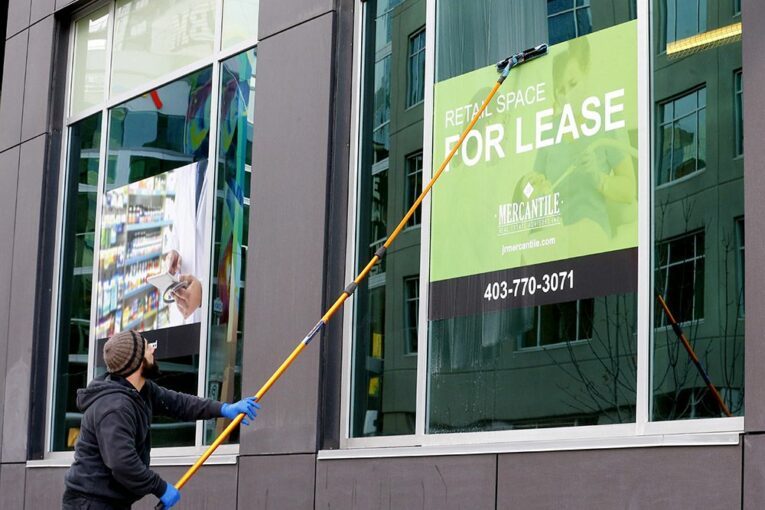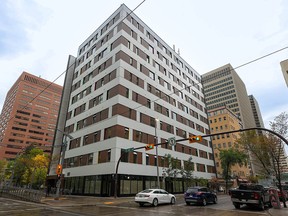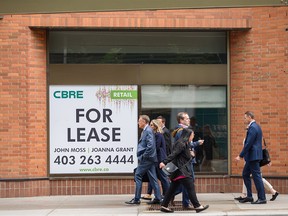
The Alberta Emergency Alert test sounded off at least five times on Wednesday, but I wonder if anyone in the UCP government actually noticed.
After all, there’s been a five-alarm fire roaring in downtown Calgary for years, yet the provincial government has done little to help.
And there are no clear signs in this week’s provincial budget that aid is on the way.
Last year, the Kenney government allocated $5 million to the cause of Calgary’s downtown. It was, in the words of Calgary’s mayor, a “pittance.”
So what‘s less than a pittance?
“I feel, as a city, we are ignored. And, personally, I feel disappointed,” said Hannes Kovac, CEO of commercial real estate firm Opus Corp.
“What is less than zero? They’re not going to take anything away.”
During a post-budget speech to the Calgary Chamber of Commerce on Thursday, Finance Minister Travis Toews faced questions on the matter, and for good reason.
Why isn’t the province helping?
Toews noted governments have limited fiscal capacity and budgets involve trade-offs.
The government’s role is to create the right business conditions to be competitive and attract investment.
Speaking to reporters, Toews said the idea of putting post-secondary schools into the downtown or converting commercial buildings into residences could become a great business proposition.

But it’s not there, yet.
“Right now, nobody’s presented me the business case for investing taxpayer dollars to support, effectively, the owners of these downtown core buildings — and many of them are pension funds located in the East, based in the East — and subsidize their transformation,” he said.
“Nobody’s made that business case for me why that’s a good investment for Alberta taxpayers.”
I get it, giving away taxpayer dollars is a dangerous game.
Those concerns are valid, but also overlook some key points.
The plight of the downtown has been under the microscope for years and the problems are not only well understood, but real solutions have been pitched.
The vacancy rate in the downtown towers remains high, still nearly double the average in major Canadian cities, according to CBRE.
Building values for downtown office towers tumbled from $21 billion in 2016 as oil prices tanked, down to $7.9 billion last year, before edging up slightly this year.
In turn, more than $160 million of tax burden has been shifted onto other commercial properties in the city, which isn’t great for small businesses.
Since the pandemic began, fewer people are coming to the core, hurting vibrancy and triggering safety concerns.
The city has done its part, earmarking $153 million to help rejuvenate the area by converting empty office buildings into residential properties. Another $9 million is targeted for transforming offices into post-secondary spots.
However, the city government can only do so much. Last year, the Opposition NDP pledged to provide $155 million in direct support to convert downtown office buildings and for infrastructure improvements, if it wins the upcoming spring election.
Meanwhile, the UCP government has largely sat on its hands on this file.
Toews said the province will work with Calgary’s city council, chamber and downtown association on improving the core.
But here’s the rub: the province has already studied the issue.
In 2021, it put together the Calgary Office Revitalization and Expansion (CORE) working group to come up with a road map for the province and private sector to follow. After almost a year of work, it came up with some solid proposals.

The report identified four key priorities, saying efforts should focus on incentivizing real estate development, supporting vibrancy initiatives, developing downtown diversity and improving downtown safety.
“Introduce financial and policy incentives to encourage post-secondary institutions and the non-profit sector to adapt and reuse vacant or outdated infrastructure,” it indicated.
University of Calgary president Ed McCauley said the post-secondary institution has examined if some faculties could play a bigger role in the downtown, and it presented some ideas to the CORE group.
However, the university couldn’t make such a move within its current funding from government.
And while it’s great the province doesn’t want to pick winners and losers, it already does.
The UCP government created the Alberta Petrochemicals Incentive Program (APIP) and is going to hand out millions of dollars — and likely a whole lot more over time — in grants that are worth 12 per cent of a petrochemical project’s capital costs.
The Smith government is examining the Rstar pilot program, now named the Liability Management Incentive Program, to look at providing $100 million in royalty credits to eligible petroleum producers to accelerate the cleanup of old oil and gas wells, even though these companies are already obligated to do so on their own.
Recommended from Editorial
-

‘Zero’s an insult’: Chamber of Commerce disappointed by lack of downtown funding in 2023 budget
-

Alberta to pilot oil and gas royalty breaks for legally required well cleanup
-

Calgary leads way in transforming office towers into housing
-

Varcoe: Value of downtown office towers rebound after years of decline
Presumably, those programs exist (or will be created) to fill a gap, correct a failure in the marketplace and deliver a return on investment to taxpayers.
Kovac, who is also chair of the real estate sector advisory committee at Calgary Economic Development, said the city’s program to convert offices to residences is triggering $5 in private-sector investment for every $1 from civic taxpayers.
It reuses older buildings. It will improve safety in the inner city after 5,000 new residents move into the area, once the first cycle of such redevelopments is done.
To date, these projects involve buildings predominantly owned by Calgary-based companies, he added.
“The real estate community of Calgary would love an opportunity to present to the minister, in person, the business case, and it will be a no-brainer,” Kovac said.
Like this week’s emergency alert tests, the downtown alarm is sounding off, again.
When will the provincial government pay attention?
Chris Varcoe is a Calgary Herald columnist.
You can read more of the news on source

